Stef Bundle
Who are the Customers Driving STEF Company's Success?
Delving into the Stef SWOT Analysis reveals the crucial role of understanding customer demographics and target market dynamics. For STEF Company, a leader in temperature-controlled logistics, identifying its ideal customer profile is not just a business strategy; it's a necessity. This exploration is critical to navigate the complexities of the food supply chain and adapt to evolving consumer behaviors.
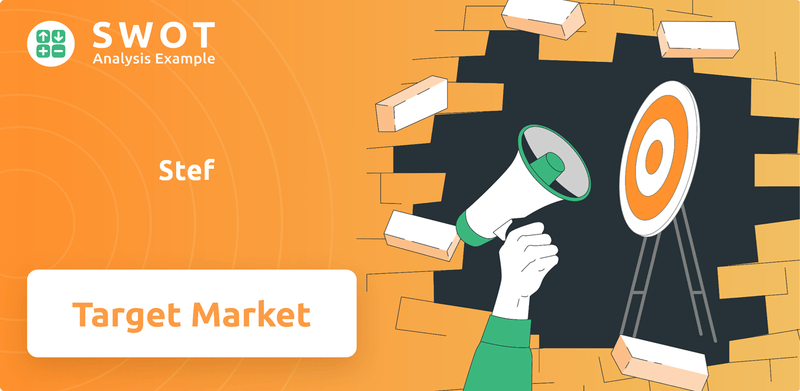
This deep dive into STEF Company's customer base will uncover the company's strategic approach to customer segmentation and market analysis. We'll examine the geographic location of STEF Company's target market and analyze customer demographics to understand the specific requirements of its diverse clientele. Understanding Stef Company's target market is key to grasping its adaptability and commitment to the temperature-controlled food logistics sector, providing actionable insights for investors and industry professionals alike.
Who Are Stef’s Main Customers?
Understanding the Competitors Landscape of Stef involves a deep dive into its primary customer segments. The company operates primarily in a Business-to-Business (B2B) model, focusing on the food industry. Its target market is defined by its position within the food supply chain and the need for reliable temperature-controlled logistics.
The Stef Company serves a diverse range of clients. These include food and beverage manufacturers, large-scale distributors and retailers like supermarkets, hotel and restaurant chains, and even pharmaceutical companies that require temperature-sensitive transport. This customer segmentation is crucial for understanding the company's market position and revenue streams.
The company's revenue breakdown provides insights into its core segments. In 2024, transportation and logistics in France accounted for 49.9% of net sales. International transportation and logistics, including countries like Italy, Spain, and the Netherlands, represented 37.5%. Other activities made up the remaining 12.6%.
While specific demographics of end consumers are not directly applicable, the business customers are defined by their needs. These needs include temperature-controlled logistics and their position within the food supply chain. This focus helps define the Stef Company's target market.
The company's target market has evolved. Strategic acquisitions, such as TransWest in Belgium and Bakker Logistiek in the Netherlands, have expanded its reach. These moves have enabled the company to enhance its service offerings and strengthen its position in key European regions.
The ideal customer is a business that requires temperature-controlled logistics solutions. These businesses are typically involved in food production, distribution, or retail. The company's focus on cold storage and transport highlights its strength in this area.
The company segments its customers based on their role in the food supply chain and geographic location. This strategy allows the company to tailor its services. The acquisitions in Northern Europe demonstrate a focus on expanding its customer base in specific regions.
The company's strategic focus on temperature-controlled logistics is a key factor in its market analysis. In 2024, these services constituted 75% of total revenue. The company reported an 8.1% increase in revenue in 2024, driven by strategic external growth and new client acquisitions.
- Food and beverage manufacturers
- Large-scale distributors and retailers
- Hotel and restaurant chains
- Pharmaceutical companies
Stef SWOT Analysis
- Complete SWOT Breakdown
- Fully Customizable
- Editable in Excel & Word
- Professional Formatting
- Investor-Ready Format
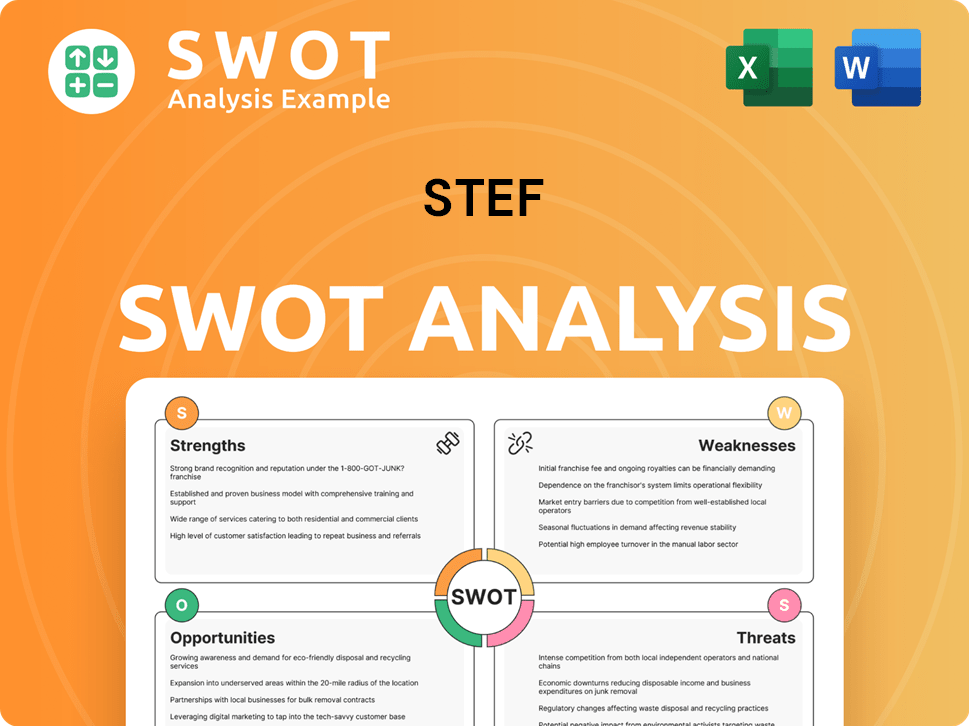
What Do Stef’s Customers Want?
Understanding the needs and preferences of customers is crucial for any business, and for the Stef Company, this involves a deep dive into the requirements of businesses within the food industry. The primary focus is on ensuring product integrity, food safety, and operational efficiency throughout the supply chain. This approach allows the company to tailor its services to meet specific demands, ultimately enhancing customer satisfaction and loyalty.
The target market for the Stef Company primarily consists of businesses in the food industry, including producers, retailers, and restaurant managers. These clients are heavily influenced by the need for comprehensive logistics solutions that cover the entire supply chain, from the point of origin to the end consumer. Key decision-making factors for these customers include integrated solutions, brand reputation, and adherence to food safety regulations.
The company's commitment to innovation, sustainability, and customer satisfaction plays a significant role in shaping its market position. By understanding and addressing these critical needs, the Stef Company not only retains its existing customer base but also attracts new clients seeking reliable and efficient logistics solutions.
The primary concern for the Stef Company's customers is maintaining the quality and safety of perishable goods. This involves strict temperature control, ranging from -25°C to +18°C, to prevent spoilage and ensure consumer health. The company's focus on reducing food spoilage rates to 1.2%, significantly below the industry average of 3% in 2023, highlights its commitment to this critical need.
Customers seek integrated logistics solutions that cover the entire supply chain. This includes transport, warehousing, and packaging services. The ability to provide a seamless, end-to-end service is a key factor in attracting and retaining clients. This approach streamlines operations and ensures the efficient handling of goods from producers to retailers.
A strong brand reputation for reliability and quality service is crucial. The Stef Company's track record and commitment to exceeding client expectations, reflected in an 89% customer satisfaction rating in 2022, are significant factors. The company aims to achieve a customer satisfaction score of over 90% in 2024.
Compliance with stringent food safety regulations is non-negotiable. The Stef Company ensures that its services meet all necessary standards, providing clients with peace of mind. This commitment is essential for maintaining trust and avoiding potential health risks.
The 'Customer First Program,' launched in 2023, demonstrates a commitment to enhancing client relations through personalized service and rapid response times. This initiative contributed to a 15% increase in repeat business. The company's focus on customer needs and preferences drives its service offerings.
Investment in research and development, with €12 million spent in 2023, focuses on digital transformation and sustainable practices. The company plans to invest around €50 million in digital transformation in 2024. Sustainability is also a priority, with a goal to reduce carbon emissions by 30% by 2030.
The Stef Company's customer demographics are primarily defined by businesses in the food industry. Understanding their needs and preferences is crucial for providing effective services.
- Temperature Control: Maintaining precise temperature control for perishable goods is paramount.
- Integrated Solutions: Clients prefer comprehensive logistics services that cover the entire supply chain.
- Reliability and Reputation: A strong brand reputation and consistent service quality are essential.
- Regulatory Compliance: Adherence to food safety regulations is a non-negotiable requirement.
- Sustainability: Growing preference for environmentally friendly logistics solutions.
Stef PESTLE Analysis
- Covers All 6 PESTLE Categories
- No Research Needed – Save Hours of Work
- Built by Experts, Trusted by Consultants
- Instant Download, Ready to Use
- 100% Editable, Fully Customizable
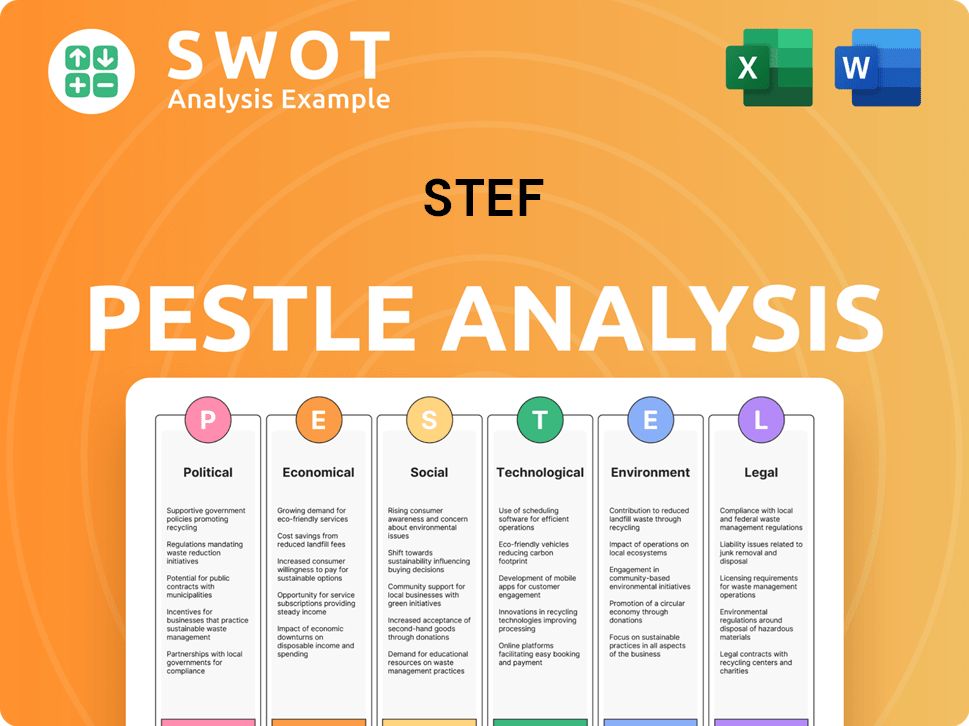
Where does Stef operate?
The geographical market presence of the company is primarily focused on Europe. The company operates in several European countries, with France being the most significant market. The company has been actively expanding its international operations to diversify its revenue streams and increase its market share.
In 2024, France accounted for 49.9% of the net sales, indicating the company's strong foothold in its home market. The company's strategic moves, such as acquisitions in Belgium and the Netherlands, highlight its commitment to expanding its presence in Northern Europe. These expansions are designed to enhance service offerings and reach a critical size in these markets.
The international division's contribution to net sales reached 37.5% in 2024, showcasing the growing importance of markets outside France. The company plans to enter at least two new European markets in 2024, anticipating a 10% revenue increase over the next three years due to this expansion. Strategic plans for 2025 include accelerating the integration of recent acquisitions, emphasizing the continued expansion and optimization of its European network.
The company's operations are concentrated in Europe, with a strong base in France. The company also has a presence in Italy, Spain, Portugal, Belgium, the Netherlands, and Switzerland.
The company is actively expanding its international activities. Acquisitions in Belgium and the Netherlands are part of this expansion strategy. The company aims to enter at least two new European markets in 2024.
In 2024, international activities contributed 37.5% of net sales. France accounted for 49.9% of net sales. The company projects a 10% increase in revenue over the next three years from expansion.
The company is focused on integrating recent acquisitions. The company is committed to strengthening its presence in Northern Europe. The company's strategic plan for 2025 emphasizes operational and cultural integration.
The company's geographical market presence is primarily in Europe, with a significant focus on France. The company's customer base is diverse, with varying needs and preferences across different regions. The company addresses these differences through localized offerings and partnerships, a key element in its Revenue Streams & Business Model of Stef.
- The company's target market includes businesses across various sectors in Europe.
- Customer segmentation is based on geographic location and specific industry needs.
- The company's ideal customer profile varies by region, considering local market dynamics.
- Market analysis is crucial for understanding the customer needs within each region.
Stef Business Model Canvas
- Complete 9-Block Business Model Canvas
- Effortlessly Communicate Your Business Strategy
- Investor-Ready BMC Format
- 100% Editable and Customizable
- Clear and Structured Layout
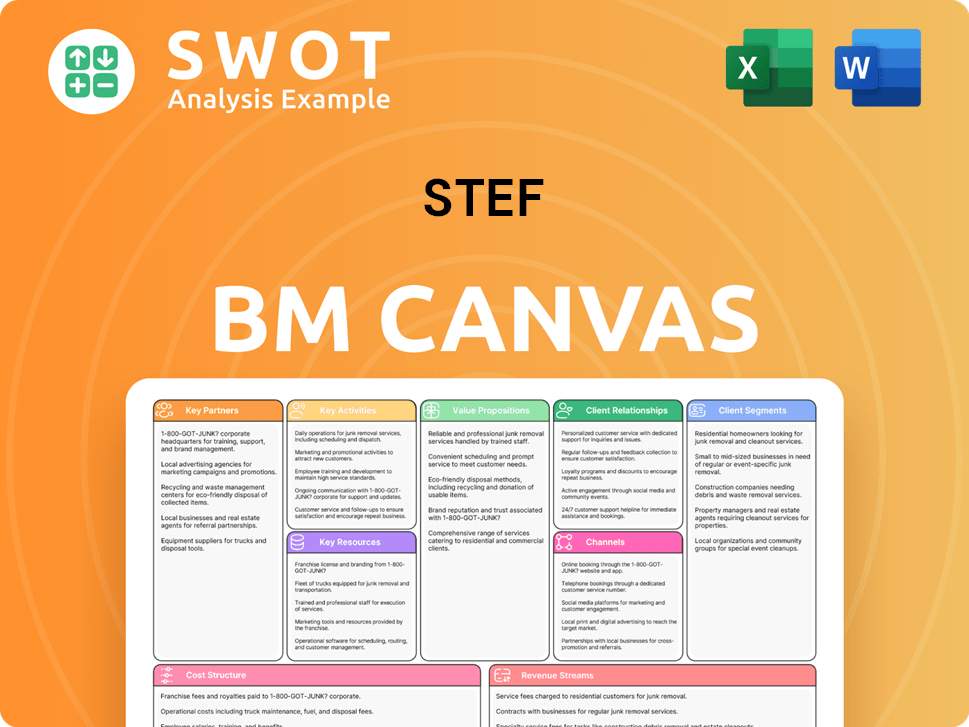
How Does Stef Win & Keep Customers?
The company, a leader in temperature-controlled logistics, uses a multi-pronged approach to both acquire and keep its business-to-business (B2B) clients. This strategy focuses on delivering high-quality services and ensuring reliability, which is critical for handling perishable food products. The company's commitment to the safety and integrity of food, alongside continuous temperature monitoring, is a key differentiator in attracting clients. The company's strong brand reputation and customer satisfaction ratings play a significant role in customer acquisition and building long-term partnerships.
Customer retention is significantly bolstered by initiatives like the 'Customer First Program,' launched in 2023. This program focuses on personalized service and fast response times, contributing to a 15% increase in repeat business. The company's ability to offer integrated solutions that cover the entire supply chain, from producers to restaurant managers, also contributes to customer loyalty by providing comprehensive support. The company also uses quarterly surveys and feedback mechanisms to improve based on client input.
The company's focus on technological innovation and sustainability also serves as an acquisition and retention strategy. Investments in digital transformation and sustainable technologies, such as energy-efficient cooling systems, appeal to businesses prioritizing efficiency and environmental responsibility. Strategic acquisitions, like TransWest and Bakker Logistiek, expand service offerings and market reach, acquiring new clients and strengthening relationships with existing ones.
The company ensures the safety and integrity of food products through continuous temperature control and real-time monitoring. This commitment to quality is a key factor in attracting and retaining clients, especially those in the food industry. The company's focus on reliability and service excellence helps build trust and long-term partnerships.
The company's strong brand reputation is a significant asset in customer acquisition. With an 89% customer satisfaction rating in 2022, the company is targeting over 90% in 2024. This positive perception helps attract new clients and fosters loyalty among existing customers. The company focuses on building a brand that customers trust.
Launched in 2023, the 'Customer First Program' emphasizes personalized service and rapid response times. This program has led to a 15% increase in repeat business. The company focuses on understanding and meeting the specific needs of each client. This approach boosts customer loyalty.
The company offers integrated solutions that cover the entire supply chain, from producers to restaurant managers. This comprehensive support contributes to customer loyalty by simplifying logistics. By providing end-to-end services, the company makes it easier for clients to manage their operations.
The company invests in digital transformation, with around €50 million planned for 2024. This focus on technology helps improve efficiency and service quality. Digital tools and processes enhance the customer experience and streamline operations.
The company invests in sustainable technologies, such as energy-efficient cooling systems. Approximately €150 million was invested in 2023. The company aims to reduce carbon emissions by 20% compared to 2021 levels by 2023, and is targeting a 30% reduction by 2030. This aligns with the environmental goals of many clients.
Acquisitions like TransWest and Bakker Logistiek expand the company's service offerings and market reach. These acquisitions help the company acquire new clients and strengthen its position with existing ones. Strategic growth through acquisitions supports long-term customer relationships.
The company's approach to customer acquisition and retention is multifaceted, emphasizing quality, reliability, and innovation. To learn more about the company's customer base, you can read this article about Stef Company's Customer Demographics.
- Focus on high-quality services and reliability, crucial for handling perishable goods.
- Emphasis on continuous temperature control and real-time monitoring.
- Strong brand reputation, with high customer satisfaction ratings.
- 'Customer First Program' for personalized service and rapid response.
- Offering integrated supply chain solutions.
- Investments in digital transformation and sustainable technologies.
- Strategic acquisitions to expand service offerings and market reach.
Stef Porter's Five Forces Analysis
- Covers All 5 Competitive Forces in Detail
- Structured for Consultants, Students, and Founders
- 100% Editable in Microsoft Word & Excel
- Instant Digital Download – Use Immediately
- Compatible with Mac & PC – Fully Unlocked
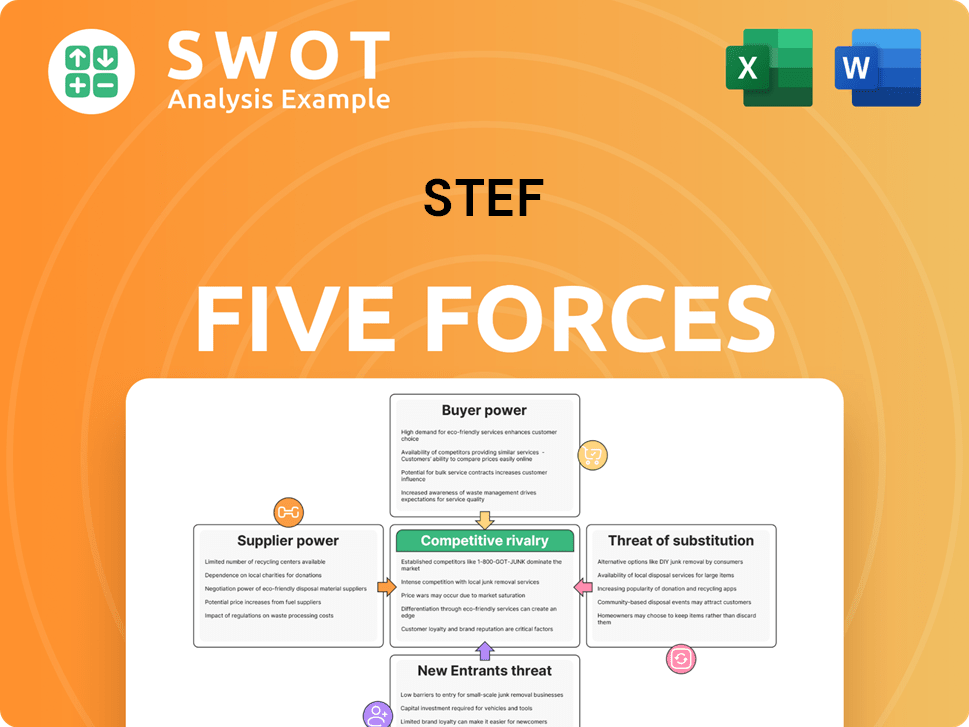
Related Blogs
- What are Mission Vision & Core Values of Stef Company?
- What is Competitive Landscape of Stef Company?
- What is Growth Strategy and Future Prospects of Stef Company?
- How Does Stef Company Work?
- What is Sales and Marketing Strategy of Stef Company?
- What is Brief History of Stef Company?
- Who Owns Stef Company?
Disclaimer
All information, articles, and product details provided on this website are for general informational and educational purposes only. We do not claim any ownership over, nor do we intend to infringe upon, any trademarks, copyrights, logos, brand names, or other intellectual property mentioned or depicted on this site. Such intellectual property remains the property of its respective owners, and any references here are made solely for identification or informational purposes, without implying any affiliation, endorsement, or partnership.
We make no representations or warranties, express or implied, regarding the accuracy, completeness, or suitability of any content or products presented. Nothing on this website should be construed as legal, tax, investment, financial, medical, or other professional advice. In addition, no part of this site—including articles or product references—constitutes a solicitation, recommendation, endorsement, advertisement, or offer to buy or sell any securities, franchises, or other financial instruments, particularly in jurisdictions where such activity would be unlawful.
All content is of a general nature and may not address the specific circumstances of any individual or entity. It is not a substitute for professional advice or services. Any actions you take based on the information provided here are strictly at your own risk. You accept full responsibility for any decisions or outcomes arising from your use of this website and agree to release us from any liability in connection with your use of, or reliance upon, the content or products found herein.